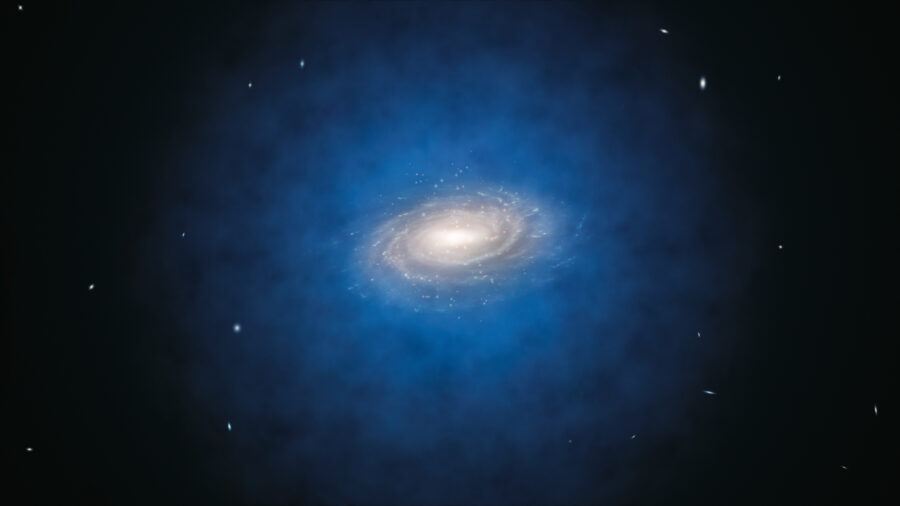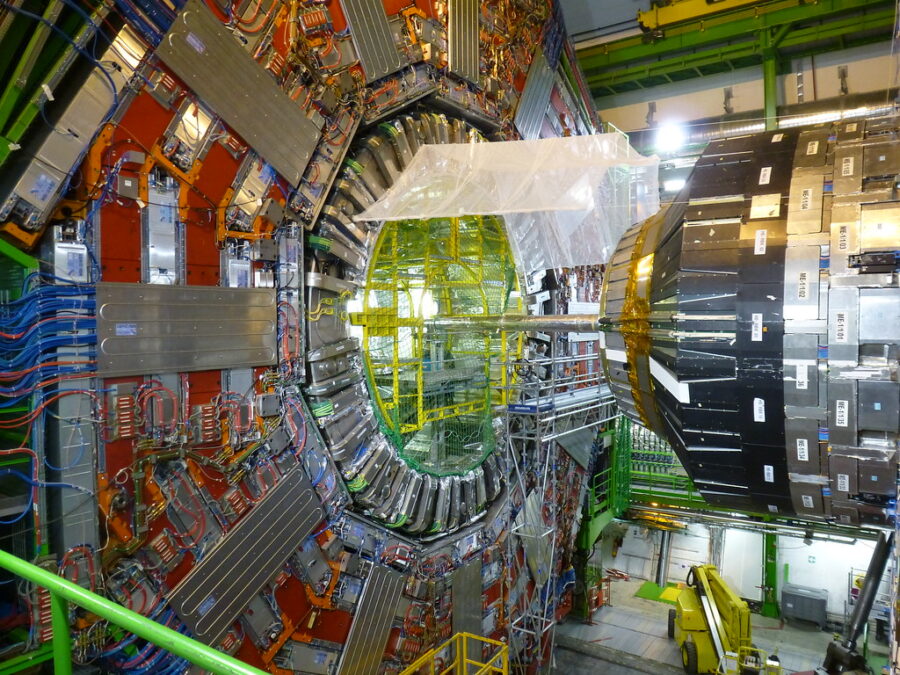What Is Dark Matter?
Dark matter is a vital ingredient thought to hold the universe together.

Since the 1920s, possibly even before this, astronomers have hypothesized that our universe holds more matter than we can see with the naked eye.
It is thought that the mass of the universe is made up of roughly 80% of material scientists cannot observe. This is dark matter, a vital dimensional ingredient thought to hold the universe together.
Dark Matter Is Thought To Keep Galaxies Intact
Without dark matter, the galaxies in our universe would seem to be achieving the impossible. Gravity can be seen only by its effects on observable matter and from that, we can see how fast a galaxy rotates. Galaxies move at such incredible speed that the math says they should have torn themselves apart a long time ago. It should be the same for galaxies in clusters.
It is for this reason that scientists theorize something out there is giving galaxies extra mass. That extra mass generates additional gravity needed to keep galaxies intact. The name given to that extra mass is believed to be dark matter.
Dark matter is called dark for a reason. It is not like normal matter in that it doesn’t interact with an electromagnetic force. This lack of interaction means it can’t absorb, emit, or reflect light, making it hard for scientists to spot.
Because of these inherent properties, proof of its existence can only be inferred by the gravitational effect on visible matter. These observations lead scientists to think dark matter outweighs visible matter six to one, representing 27% of the universe. Visible matter known that makes up all the galaxies and stars account for a mere 5% of the content of the universe.
Even though the evidence is lacking, support for dark matter’s existence continues to grow. Researcher Pieter van Dokkum from Yale University observed in a statement, “Motions of the stars tell you how much matter there is. They don’t care what form the matter is, they just tell you that it’s there.”
Van Dokkum is noted for leading a team that identified the galaxy Dragonfly 44, which they estimate is made up of 99.9% dark matter.
Dark Matter Isn’t Black holes Or Antimatter
It may be easier to explain what dark matter isn’t than what it actually comprises. Scientists put a theoretical model of the universe together and came up with a composition that includes 68% of dark energy, 27% of dark matter, and 5% of normal matter.
We know it is dark, so it is not in the form of planets or stars that we see. It is not in the form of dark clouds seen in normal matter. These clouds are made up of baryons that absorb radiation as it passes through. Scientists would be able to see this happen.
We know dark matter is not antimatter because scientists do not see the gamma rays produced when antimatter annihilates matter.
Lastly, galaxy-sized black holes can be ruled out. Not enough events known as a gravitational lens (the distribution of matter between an observer and a distant light source capable of bending light. Bending light happens as the light moves toward the observer) are seen by scientists to suggest black holes are part of the dark matter equation.
Dark Matter Theories
Even though there is much we don’t know or can see, belief in dark matter continues and there are several theories to explain it that scientists are putting forth.
One theory is that it contains supersymmetric particles, which are believed to be partners with the already-known particles. These particles are themselves another hypothesis.
Another theory out there is the suggestion of the existence of a “Hidden Valley”. This hidden valley is thought to be a parallel world made of dark matter that has little in common with matter as we know it.
Kathryn Zurek, a theoretical physicist at the Department of Energy’s Lawrence Berkeley National Laboratory (Berkeley Lab), developed her theory along with collaborator Matthew J. Strassler, a faculty member, in a published report.
Zurek’s reasoning behind Hidden Valley? It seemed to her that scientists were hunting in the dark for answers. “I noticed from a model builder’s point of view that dark matter was extraordinarily undeveloped. People were focused on models of just two classes of dark matter candidates, rather than a much broader array of possibilities.”
More realistic views on dark matter say that it may actually be made of baryonic or non-baryonic matter. The baryonic matter would include dim brown dwarfs, white dwarfs, and neutron stars.
These often hard-to-spot objects would have to be a much more dominant role than what scientists to this point have observed to make up all the missing mass.
Most scientists seem to think dark matter is made of non-baryonic matter. WIMPS (weakly interacting massive particles) lead the way as they have ten to a hundred times the mass of a proton.
However, they are very difficult to detect as their interaction with normal matter is extremely weak. This is why they feel it can’t be seen.
While dark matter can’t be seen, it’s felt that it may account for almost one-quarter of the universe’s mass-energy. Why is this important? If it wasn’t for this kind of gravity, galaxies could not be held together and planets and stars would go flying off independently.

The unknown continues to push for more and more research on the reality of this mysterious element. Scientists are hoping more experiments with the Large Hadron Collider (LHC) may provide a better idea of what makes dark matter.
The LHC is the world’s most powerful and largest particle accelerator. Theorists believe that there is one particular type of dark particle, one that is heavier and lives longer than other known particles, that only occasionally interacts with normal matter. It’s believed that a few times in a decade this particle can get caught up in the collisions of protons constantly created and measured by LHC.
Some Think There Was A Dark Big Bang
Then there is what cosmologists are calling a “Dark” Big Bang or a second Big Bang. In a new study, they theorize that this Dark Big Bang came after the initial one, ultimately flooding our universe with the mysterious dark matter.
Prevailing wisdom says that right after the Big Bang, our cosmos went through a rapid expansion known as inflation. What triggered inflation is still up for debate but after this expansion, the Dark Big Bang is thought to have occurred.
Now, because dark matter and normal matter do not interact with each other, cosmologists hypothesize that a new quantum (dark) field was in existence that was necessary to allow it to form independently. Under their new theory, the second Big Bang can only commence after inflation ceases, and the universe expands and cools enough to allow the dark field to transition into dark matter particles.
As they went about putting their new theory together, the researchers discovered that for this Dark Big Bang to occur, it had to adhere to certain constraints. If it happened too early then there would be way too much dark matter today, and if it happened too late, there would be too little dark matter.
Conversely, if it happened at the right time, in this case when our universe was less than one month of age, then it would fit with all observations.
Dark Big Bang Allows For Better Modeling
As cosmologists have theorized, there are a number of advantages to introducing the possibility of a second Big Bang. The first thing is that it’s consistent with dark matter and what scientists know about it: there is no reason for dark and normal matter to share the same origin if they don’t interact.
Secondly, this Dark Big Bang theory allows scientists to have much more flexibility in creating models. This is because they would no longer have to worry about how dark matter would affect normal matter.
What researchers found was most important, though, was that a Dark Big Bang gravitational waves with a particular signature. This signature appears as ripples in space-time that can be seen today. The key benefit to that is that one day, this theory could be testable.
Dark Matter Conclusion
The brightest minds with the world’s most advanced tools will not stop until the light is shed on the grand mystery of dark matter.
On a cloudless night away from city lights the sky can be an impressive sight. Stars and planets twinkle their existence, teasing questions about what’s really out there. Our universe is vast and there’s more to know than we can even imagine. Understanding dark matter may just be the beginning of an entirely new kind of knowledge.












